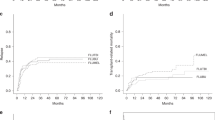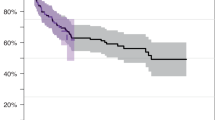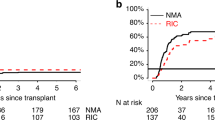Abstract
This study shows the long-term updated outcomes of a multicenter retrospective study which analyzed 843 patients with myelodysplastic syndrome (MDS) who underwent transplantation with an HLA-identical sibling donor with either reduced-intensity conditioning (RIC) in 213 patients, or standard myeloablative conditioning (MAC) in 630 patients. In multivariate analysis, the 13-year relapse rate was significantly increased after RIC (31% after MAC vs 48% in RIC; HR, 1.5; 95% CI, 1.1–1.9; P=0.04), but with no differences in overall survival (OS) (30% after MAC vs 27% in RIC; P=0.4) and PFS (29 vs 21%, respectively, P=0.3). Non-relapse mortality was higher in MAC (40 vs 31%; P=0.1), especially in patients older than 50 years (50 vs 33%, P<0.01). In addition, long-term follow-up confirms the importance of other variables on 13-year OS, mainly MDS risk category, disease phase, cytogenetics and receiving a high donor cell dose, irrespective of the conditioning regimen used.
This is a preview of subscription content, access via your institution
Access options
Subscribe to this journal
Receive 12 print issues and online access
$259.00 per year
only $21.58 per issue
Buy this article
- Purchase on Springer Link
- Instant access to full article PDF
Prices may be subject to local taxes which are calculated during checkout



Similar content being viewed by others
References
Onida F, Brand R, van BA, Schaap M, von dem Borne PA, Maertens J et al. Impact of the International Prognostic Scoring System cytogenetic risk groups on the outcome of patients with primary myelodysplastic syndromes undergoing allogeneic stem cell transplantation from human leukocyte antigen-identical siblings: a retrospective analysis of the European Society for Blood and Marrow Transplantation-Chronic Malignancies Working Party. Haematologica 2014; 99: 1582–1590.
Kroger N, Zabelina T, de Wreede L, Berger J, Alchalby H, van Biezen A et al. Allogeneic stem cell transplantation for older advanced MDS patients: improved survival with young unrelated donor in comparison with HLA-identical siblings. Leukemia 2013; 27: 604–609.
Brand R, Putter H, van BA, Niederwieser D, Martino R, Mufti G et al. Comparison of allogeneic stem cell transplantation and non-transplant approaches in elderly patients with advanced myelodysplastic syndrome: optimal statistical approaches and a critical appraisal of clinical results using non-randomized data. PLoS ONE 2013; 8: e74368.
Malcovati L, Hellstrom-Lindberg E, Bowen D, Ades L, Cermak J, Del CC et al. Diagnosis and treatment of primary myelodysplastic syndromes in adults: recommendations from the European LeukemiaNet. Blood 2013; 122: 2943–2964.
Deschler B, de Witte T, Mertelsmann R, Lubbert M . Treatment decision-making for older patients with high-risk myelodysplastic syndrome or acute myeloid leukemia: problems and approaches. Haematologica 2006; 91: 1513–1522.
Alessandrino EP, Porta MG, Malcovati L, Jackson CH, Pascutto C, Bacigalupo A et al. Optimal timing of allogeneic hematopoietic stem cell transplantation in patients with myelodysplastic syndrome. Am J Hematol 2013; 88: 581–588.
Martino R, de Wreede L, Fiocco M, van Biezen A, von dem Borne PA, Hamladji RM et al. Comparison of conditioning regimens of various intensities for allogeneic hematopoietic SCT using HLA-identical sibling donors in AML and MDS with <10% BM blasts: a report from EBMT. Bone Marrow Transplant 2013; 48: 761–770.
Martino R, Iacobelli S, Brand R, Jansen T, van BA, Finke J et al. Retrospective comparison of reduced-intensity conditioning and conventional high-dose conditioning for allogeneic hematopoietic stem cell transplantation using HLA-identical sibling donors in myelodysplastic syndromes. Blood 2006; 108: 836–846.
Finke J, Schmoor C, Bertz H, Marks R, Wasch R, Zeiser R et al. Long-term follow-up of therapy-related myelodysplasia and AML patients treated with allogeneic hematopoietic cell transplantation. Bone Marrow Transplant 2016; 51: 771–777.
Potter VT, Krishnamurthy P, Barber LD, Lim Z, Kenyon M, Ireland RM et al. Long-term outcomes of alemtuzumab-based reduced-intensity conditioned hematopoietic stem cell transplantation for myelodysplastic syndrome and acute myelogenous leukemia secondary to myelodysplastic syndrome. Biol Blood Marrow Transplant 2014; 20: 111–117.
Boehm A, Sperr WR, Kalhs P, Greinix H, Valent P, Worel N et al. Long-term follow-up after allogeneic stem cell transplantation in patients with myelodysplastic syndromes or secondary acute myeloid leukemia: a single center experience. Wien Klin Wochenschr 2014; 126: 23–29.
Wingard JR, Majhail NS, Brazauskas R, Wang Z, Sobocinski KA, Jacobsohn D et al. Long-term survival and late deaths after allogeneic hematopoietic cell transplantation. J Clin Oncol 2011; 29: 2230–2239.
Atallah E, Abrams J, Ayash L, Bentley G, Abidi M, Ratanatharathorn V et al. Long term follow-up of allogeneic stem cell transplantation in patients with myelodysplastic syndromes using busulfan, cytosine arabinoside, and cyclophosphamide. Am J Hematol 2010; 85: 579–583.
Shimoni A, Hardan I, Shem-Tov N, Yerushalmi R, Nagler A . Allogeneic hematopoietic stem-cell transplantation in AML and MDS using myeloablative versus reduced-intensity conditioning: long-term follow-up. Leukemia 2010; 24: 1050–1052.
la Porta MG, Alessandrino EP, Bacigalupo A, van Lint MT, Malcovati L, Pascutto C et al. Predictive factors for the outcome of allogeneic transplantation in patients with MDS stratified according to the revised IPSS-R. Blood 2014; 123: 2333–2342.
Neukirchen J, Lauseker M, Blum S, Giagounidis A, Lubbert M, Martino S et al. Validation of the revised international prognostic scoring system (IPSS-R) in patients with myelodysplastic syndrome: a multicenter study. Leuk Res 2014; 38: 57–64.
Lee JH, Lee JH, Lim SN, Kim DY, Kim SH, Lee YS et al. Allogeneic hematopoietic cell transplantation for myelodysplastic syndrome: prognostic significance of pre-transplant IPSS score and comorbidity. Bone Marrow Transplant 2010; 45: 450–457.
Nevill TJ, Shepherd JD, Sutherland HJ, bou Mourad YR, Lavoie JC, Barnett MJ et al. IPSS poor-risk karyotype as a predictor of outcome for patients with myelodysplastic syndrome following myeloablative stem cell transplantation. Biol Blood Marrow Transplant 2009; 15: 205–213.
Mukherjee S, Boccaccio D, Sekeres MA, Copelan E . Allogeneic hematopoietic cell transplantation for myelodysplastic syndromes: lingering uncertainties and emerging possibilities. Biol Blood Marrow Transplant 2015; 21: 412–420.
Raimondi R, Tosetto A, Oneto R, Cavazzina R, Rodeghiero F, Bacigalupo A et al. Validation of the hematopoietic cell transplantation-specific comorbidity index: a prospective, multicenter GITMO study. Blood 2012; 120: 1327–1333.
Kroger N . Allogeneic stem cell transplantation for elderly patients with myelodysplastic syndrome. Blood 2012; 119: 5632–5639.
Parmar S, de Lima M, Deeg HJ, Champlin R . Hematopoietic stem cell transplantation for myelodysplastic syndrome: a review. Semin Oncol 2011; 38: 693–704.
Warlick ED . Optimizing stem cell transplantation in myelodysplastic syndromes: unresolved questions. Curr Opin Oncol 2010; 22: 150–154.
Scott BL, Pasquini MC, Logan B, Wu J, Devine S, Porter DL et al. Results of a phase III randomized, multi-center study of allogeneic stem cell transplantation after high versus reduced intensity conditioning in patients with Myelodysplastic Syndrome (MDS) or Acute Myeloid Leukemia (AML): Blood and Marrow Transplant Clinical Trials Network (BMT CTN) 0901. Blood 2015; 126 (23). Late Breaking Abstracts 8.
Acknowledgements
Author contributions
RM designed the study, performed data analysis and wrote the various versions of the manuscript. AH was the main data manager. MR, TdW and NK designed the study, coordinated all the steps from design to the final data analysis, and participated in the development of all versions of the manuscript. All other coauthors participated in data management and in the development of all versions of the manuscript.
Author information
Authors and Affiliations
Consortia
Corresponding author
Ethics declarations
Competing interests
The authors declare no conflict of interest.
Additional information
Supplementary Information accompanies this paper on Bone Marrow Transplantation website
Supplementary information
Rights and permissions
About this article
Cite this article
Martino, R., Henseler, A., van Lint, M. et al. Long-term follow-up of a retrospective comparison of reduced-intensity conditioning and conventional high-dose conditioning for allogeneic transplantation from matched related donors in myelodysplastic syndromes. Bone Marrow Transplant 52, 1107–1112 (2017). https://doi.org/10.1038/bmt.2017.19
Received:
Revised:
Accepted:
Published:
Issue Date:
DOI: https://doi.org/10.1038/bmt.2017.19
This article is cited by
-
Impact of myelofibrosis on patients with myelodysplastic syndromes following allogeneic hematopoietic stem cell transplantation
Journal of Translational Medicine (2024)
-
Outcome improvement over time in reduced intensity conditioning hematopoietic transplantation: a 20-year experience
Annals of Hematology (2024)
-
Fit older adults with advanced myelodysplastic syndromes: who is most likely to benefit from transplant?
Leukemia (2021)
-
The prognostic impact of the cytomegalovirus serostatus in patients with chronic hematological malignancies after allogeneic hematopoietic stem cell transplantation: a report from the Infectious Diseases Working Party of EBMT
Annals of Hematology (2019)



